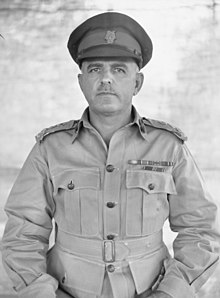
Back روبرت هارولد نيمو Arabic روبيرت هارولد نيمو ARZ Robert Nimmo Spanish رابرت هارولد نیمو Persian Robert Nimmo French רוברט נימו HE Robert Nimmo Portuguese Robert Harold Nimmo Slovenian Robert Harold Nimmo Vietnamese
Robert Nimmo | |
|---|---|
 Nimmo in 1945 | |
| Nickname(s) | "Putt" |
| Born | 22 November 1893 Einasleigh, Queensland |
| Died | 4 January 1966 (aged 72) Rawalpindi, Pakistan |
| Buried | |
| Service/ | Australian Army then United Nations |
| Years of service | 1912–1966 |
| Rank | Lieutenant General |
| Service number | QX23797[1] |
| Unit | 5th Light Horse Regiment |
| Commands held |
|
| Battles/wars | |
| Awards | |
| Spouse(s) | Joan Margaret Cunningham
(m. 1921–1940)Mary Dundas Page
(m. 1942–1966) |
| Children | 4 |
Lieutenant General Robert Harold Nimmo, CBE (22 November 1893 – 4 January 1966) was a senior Australian Army officer who served in World War I, in World War II, with the British Commonwealth Occupation Force in Japan, as general officer commanding (GOC) Northern Command in Australia, and finally as the chief military observer of the United Nations Military Observer Group in India and Pakistan from 1950 until his death in 1966. Raised on a sheep station in far north Queensland, Nimmo attended the Southport School in southern Queensland before entering the Royal Military College, Duntroon, in 1912. He was the senior cadet of his class, graduating early to participate in World War I. He served with the 5th Light Horse Regiment during the Gallipoli and Sinai and Palestine campaigns, reaching the rank of major. He was praised for his leadership as a light horse squadron commander and for his skills as the brigade major of the 1st Light Horse Brigade in the final stages of the war.
At the end of the war, Nimmo transferred to the permanent Australian Staff Corps, and served as a company commander and instructor at Duntroon before a series of staff postings at cavalry formations in Victoria. He was also a talented sportsman, representing Australia in field hockey, and the state of Victoria in a range of sports. After attending the British Army's Senior Officers' School, he was promoted to lieutenant colonel and served as a senior staff officer on the headquarters of two cavalry divisions. At the outbreak of World War II, he was initially retained in Australia to help develop an Australian armoured force, and was subsequently promoted to brigadier and commanded a cavalry and then an armoured brigade in Australia. Following this he was posted as a senior staff officer at corps and then at army headquarters level in Australia. Nimmo administered command of Northern Territory Force before deploying to the island of Bougainville in the Territory of New Guinea to command the 4th Base Sub Area, the logistics organisation supporting the Bougainville campaign. His final posting of the war was as a senior staff officer on First Australian Army headquarters in Lae in New Guinea.
Soon after the Japanese surrender, Nimmo was selected to command the 34th Brigade, and led it from Morotai in the Dutch East Indies to Japan, where it formed part of the British Commonwealth Occupation Force. Upon returning from Japan to Australia, he was promoted to major general and posted as GOC Northern Command. He was appointed as a Commander of the Order of the British Empire in 1950, and retired from the army at the end of that year. Almost simultaneously he was appointed as the chief military observer of the UN Military Observer Group in India and Pakistan (UNMOGIP), responsible for monitoring the 800-kilometre-long (500 mi) ceasefire line between the Indian and Pakistani armed forces, which extended from the Kashmir Valley to the Himalayas. He was promoted by Australia to honorary lieutenant general in 1954, at the suggestion of the United Nations. In 1964, the UN Secretariat described him as "by far the most successful United Nations observer ever". He died of a heart attack in his sleep on 4 January 1966 at Rawalpindi, Pakistan, and was buried in the Anzac section of Mount Gravatt Cemetery, Brisbane, with full military and United Nations honours and senior representatives of both India and Pakistan were present. Nimmo was the first Australian to command a multinational peacekeeping force, and his command of UNMOGIP remains the longest-ever command of a UN operation.
- ^ National Archives 2022, p. 3.